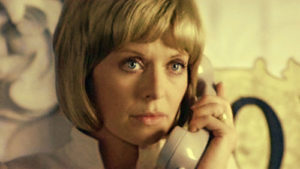STUDIO: Arrow | DIRECTOR: Robert Altman | CAST: Susannah York, Rene Auberjonois, Marcel Bozzuffi, Hugh Millais, Cathryn Harrison
RELEASE DATE: 3/20/18 | PRICE: Blu-ray $22.97
BONUSES: Audio commentary by Samm Deighan and Kat Ellinger, scene-specific commentary by Robert Altman, featurette with Altman and cinematographer Vilmos Zsigmond, new interview with Cathryn Harrison, appreciation by musician and author Stephen Thrower
SPECS: R | 101 min. | Thriller | 2.35:1 widescreen | mono
Like many of Robert Altman’s box-office failures, the brilliant 1972 thriller Images has acquired a cult following in the years since its initial release. Arrow’s beautifully restored release of the film on Blu-ray shows Altman’s dreamy visuals and the exquisite camerawork and lighting of Vilmos Zsigmond off to best effect.
The plot centers around the mental breakdown of a children’s book author. Cathryn (Susannah York, The Killing of Sister George) has visions of her dead lover Rene (Marcel Bozuffi) and is haunted by a version of herself that crops up periodically. Her husband Hugh (Rene Auberjonois, McCabe & Mrs. Miller) is baffled by her behavior, but horny friend Marcel (Hugh Millais) does his best to take advantage of her delusional state.
Although Images is crammed to capacity with great “shock” moments, the film is a minimalist work, by Altman’s standards. There are only two settings — an upscale apartment and a summer house in unidentified UK countryside (actually Ireland), with only six actors appearing in the entire film.
Zsigmond, then Altman’s cinematographer of choice, crafts memorable visuals, augmented by a suitably jarring soundtrack by John Williams, punctuated with odd noises supplied by experimental Japanese percussionist Stomu Yamashta.
As was always the case with Altman’s pictures, the ensemble cast work together beautifully. The men incarnate a range of male “types,” from the romantic cipher (Rene) to full-fledged predator (Marcel) to a jokey, “liberated” spouse (Hugh); each of them, at one point or another, seems to merely be a projection of Cathryn’s anxieties.
York is superb, especially in the later sequences, in which Cathryn seems to take her schizo delusions in stride and refuses to be scared by situations that make no sense at all. Her brilliantly nuanced performance won her the Best Actress award at the Cannes Film Festival in 1972.
 Two of the five supplements on the disc were created for the 2003 MGM DVD release of the film. They offer invaluable insights, since they both consist of Altman (who died in 2006) willingly explaining what is happening in the picture.
Two of the five supplements on the disc were created for the 2003 MGM DVD release of the film. They offer invaluable insights, since they both consist of Altman (who died in 2006) willingly explaining what is happening in the picture.
A scene-specific audio commentary done for the MGM disc finds Altman offering very concrete explanations for Catherine’s behavior. An odd thing for the director of such an esoteric thriller to do, but Altman was a died-in-the-wool contrarian, so one assumes he decided to spell out the nuances here to reflect on Catherine’s schizophrenia (mentioned only once in the film by Marcel as a put-down).
An onscreen interview for the MGM disc has Altman stating that the main influence on Images was Bergman’s Persona (which he later drew on for his equally trippy 3 Women). He discusses the production of the film in detail and notes that he would do anything to avoid “behavior” questions from cast members. He wanted the performers he worked with to find their own conclusions; his role, he claims, was merely to say, “Show me your stuff!”
A new full-length audio commentary by horror-movie specialists and podcast hosts Samm Deighan and Kat Ellinger focuses on various aspects of the film, from historical details about its filming to its place in the cycle of female-centric horror films of the Sixties and early Seventies to the ways in which Altman overturns various horror movie conventions.
In an interview shot for this package, actress Cathryn Harrison, who plays Marcel’s child Susannah in the film, talks about meeting Altman while on vacation with her parents in Spain. He cast her in Images soon after that, and she participated in a series of improvisational exercises held for the cast to develop their characters.
Harrison, who was 12 when she was in the film, also discusses the fact that Altman indulged in a name game by giving each character the first name of another performer in the film.
A half-hour “appreciation” of the film by musician-horror movie historian Stephen Thrower includes info about the film’s financing that Altman conveniently left out of his discussion of the film. Thrower notes that no American studio would fund the film, so Altman raised the money himself and then worked with Hemdale Films to get it finished and released. (This moves into an amusing discussion about how many box-office flops Hemdale had in the early Seventies.)
The common perception of the film as a complete failure is a myth, according to Thrower. He maintains that — while it made very, very little money — it was indeed a critical success in Europe and America, with the notable exception of a vicious review that came from, no surprise, Rex Reed.
Perhaps the best statement about Altman and an ambitious but seemingly doomed film like Images is supplied by the filmmaker himself in the onscreen interview. When he reflects on the inevitable question he was asked about which of his films he loved the most, the prolific (and sarcastic) auteur would ask the questioner, “Which one did you like the least?” and then go with that title as his answer….
|
Buy or Rent Images
on Blu-ray
|
|---|
Leave a Reply